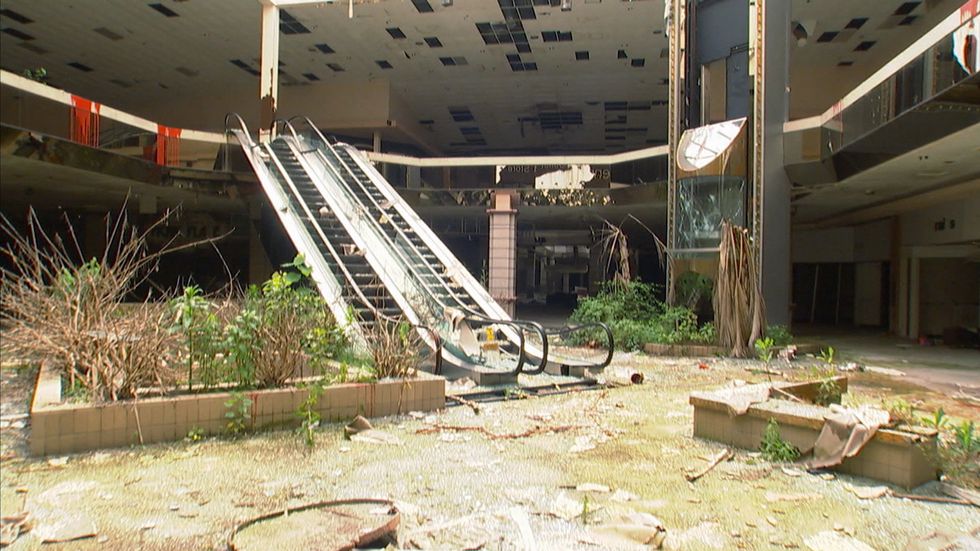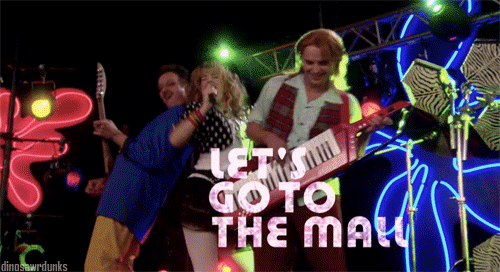As an American female, I can confidently say that I adore the mall. I love walking into a building full of stores and cute clothes and maybe even a pet store full of adorable puppies that smells like soft pretzels and Cinnabon. I love people watching, eating greasy food in the food court, going into PINK and Hot Topic and spending way too much money on bras and hoodies and band tees that I don't need, and stopping at Pinkberry on the way home for an original topped with pink boba. Malls are a part of American culture. So many things in our lives happen in malls. They are a place for shopping as well as socializing, especially among teens. However, the American mall is dying, and what are we doing to stop it? Well, nothing!
This was brought to
my attention on a lonely Friday night while I was watching make up
and hair tutorials on YouTube. I came across a video of an abandoned
mall (I couldn’t find the actual video, but go on YouTube – there
are TONS of them!). The creepiness of it sort of caught my interest, and
I started looking at photos of malls that had closed and left to rot
and fall apart. It seemed odd to me that a building so large and full
of stores and restaurants would shut down. It wasn’t until recently
that I actually looked into exactly why these malls had closed. Well,
after some research, it all made sense.
Culture has changed a lot since malls first became a thing. The Country Club Plaza opened in 1922 in Kansas City, Missouri, and became the first mall, but it was not enclosed. The first enclosed shopping center opened in 1956 in Edina, Minnesota. These malls were not the kind of large malls you know today – they were more like small shopping centers. The structure was very well thought out – placing the anchor or “big box” stores on the ends, and placing smaller stores in the middle. The thought was shoppers wanted to hit the larger stores first, and would place them at either end of the complex to draw shoppers into the smaller stores as they went from end to end – a concept we still use today. In the 1950s was when people started moving to the suburbs. Highways were build, the car industry was taking off, and the credit card was invented. The idea that you could get up and go somewhere to do all of your shopping was revolutionary. There was also no internet, and driving place and place had gotten easier with the newly built highway system. People wanted to get out, drive in their cars, and shop. The stay at home mother is a 50s icon, and when she was done with her daily chores, she hit the mall rather than sitting around. Television allowed stores to advertise to Americans in a new, visual way. Things were changing, and these changes favored malls. The opposite is happening now -- changes are killing malls all over the globe.
The types of malls we know of now didn’t pop up until the 1980s, when West Edmonton Mall opened in Alberta, Canada in 1981. This massive mall featured more than 800 stores, a church, amusement park, mini golf course, a hotel, water park, and a 438 foot lake! Many other “mega-malls” followed, including our very own Mall of America, which opened in 1992 in Blooming, Minnesota, and is owned by the same company that owns West Edmonton Mall in Canada. In the late 19th century, malls began adding restaurants and move theaters to their list of attractions to reel in more shoppers. Today, malls make up 8% of retail space in the United States. So, why are they closing? I guess the reason why stems in many different directions, but it all has to do with one thing – a change in our culture. Today, we have computers and cells phone and tablets, which allows shoppers to buy online from the comfort of their home. Young people also hangout at malls much less. There are a lot of factors involved with the closing of malls. Let’s take a look at them.
Our lives have gotten significantly busier in the last several years. Between work, school, commuting and carpooling, we spend more time on the go than we use to. There are multiple ways today to buy items without going to the store. Before computers, we ordered items via mail order catalog. The first mail order catalog was sent out in 1872 by Aaron Montgomery Ward for his business. He was a traveling salesman for Marshall Field, which was a retail store located in a rural area. Ward thought it would be a revolutionary idea to mail out a catalog to customers in rural areas. His first catalog was a single sheet of paper with a list of items and their prices and ordering instructions. These single sheets of paper grew over time into thicker books completed with photos of items, their prices, and ordering instructions for both telephone and eventually, online. The mail order catalog was invited as a way of convince for customers. It allowed customers to see what the stores had in store, but also gave them the option to order from home. Of course, back when the catalog was invented, it was easier to travel to the store. Now, we are so caught up in our day-to-day lives that we have neglected the brick and mortar store and began order items online as we wait in traffic.
Today, this order-from-home idea has been taken to the next level. Stores have become virtual, causing many of our favorite retailers to close their doors, and for malls to become deserted. Big box stores like Macy’s, Sears, and JCPenney are what keep many malls afloat, and with these stores closing their doors left and right, malls are become empty shells that are relying on smaller retailers to keep them going. With the economy still recovering from the 2008 financial crisis, people are trying to save money. No one is making plans to spend their day shopping at the mall, because they are trying to save. People are also working more to make money to support their families. Along with that, stores cannot afford to hire new employees, because no one is shopping in-store, and they aren’t making enough money to pay their rents and leases – same goes for the mall itself. If shoppers aren’t shopping, stores cannot afford to stay open. If the stores are closing, the mall attracts less shoppers. It’s a chain reaction.
Many malls and shopping centers have added movie theaters and more dining options to their list of attractions, as well as higher end stores to attract a more sophisticated customer. When discount stores enter a mall, the customer base is people who can afford discount items, which typically isn't someone who has the time or money to spend the day at the mall. Many shopping centers are now going back to an outdoor style. Many shopping plazas are adding high end stores. For instance, in my home state of Massachusetts we have many outdoor shopping malls such as Legacy Place in Dedham, that features an LL Bean store, Whole Foods, movie theater, Shake Shack, and many high end stores. Patriot Place in Foxboro is located right next to Gillette Stadium, and features a movie theater, many high end restaurants and stores, a Trader Joes, Bass Pro Shop, and a Patriots Pro Shop where shoppers can buy New England Patriots gear. You can also visit the Hall of Fame, which is a true Pats Fan's dream! Attractions like these are what drive shoppers today, and those malls that don't adapt are losing customers, and will eventually close their doors. The poster child of closed malls is Rolling Acres mall in Ohio (featured in the "cover photo" for this article), which was once a huge shopping mall with hundred of stores at it's peak after is opened in the mid 1970s. The mall closed in 2008 as a result of the financial crisis. Today, part of the mall is a storage facility, and the rest of it? Vandalized, destroyed, and left to crumble.
There are many stores that don’t exist in the brick-and-mortar world, like ASOS, Zulily, or Zappos. Many brick-and-mortar retailers now offer “online only” items, sales, and coupons. For example, I am a huge American Eagle shopper, and many of their promotions are for online orders, and even more of their products are online only. Plus, if you shop on the app, you get so much off your order. The money still goes to AE, which is great, but no one is going into the mall. So, your local mall’s American Eagle isn’t getting the money they need to pay their rent, causing them to close their doors and creating an empty space in the mall. I’ve said it over and over – no stores, no shoppers, no malls. The online shopping world is great and "oh-so convenient", but maybe get up and go to the mall? Get the experience! People hate crowds and waiting in line to check out, and I understand that. I am the same way, but the mall is more than just retail – it’s an experience that we are not taking advantage of. On the plus side, many retailers offer a site-to-store option now. Shoppers can have items online shipped to stores for free. This allows shoppers to visit stores to pick up their packages, but also to see what the store carries. They just might leave with something else they spot on their way to pick up their online order.
We’ve all seen girls in those 80s and 90s movies with their elaborate outfits that hit the mall. Back then, the mall was as much a social experience as it was a retail experience. I think of movies like "Clueless" and "Fast Times at Ridgemont High" when I think of malls. In "Fast Times", 99% of the characters work somewhere in the mall. Cher spends a lot of time in the mall in "Clueless", and she is seen a lot with a shopping bag in her hand. Even in shows like "Full House" I think of the episode where Stephanie steels a purple sweater for DJ at the mall, or when DJ skips school to get a singers autograph. "How I Met Your Mother" fans think of Robin Sparkles and the song "Let's Go to the Mall". Back in the 80s, singers like Tiffany rose to fame performing concerts in malls for young people, because that is where they hung out. Young people use to hang out at the mall, and they still do, but they do it a lot less now. In the past decade, the amount of teens that go to the mall has decreased by 30%. In 2007, teens averaged 38 visits to the mall that year. The number decreased in 2014 to 29, and those who did visit the mall that year spent more money on food than they did on clothing. Today, more teens hang out in restaurants rather than in malls. The reason why is unclear, but researchers are suspecting that the next generation of young people will flock to restaurants than malls. Young people are also socializing online or spending their free time watching Netflix.
We can also put into consideration (as far as the absence of teens in malls) that the threat of mass shootings, terror attacks, and other similar events has gone up significantly. One instance of violence at a mall happened in Nebraska when nineteen year old Robert Hawkins entered Westroads Mall. Hawkins shot and killed eight people and wounded six others before he killed himself. This shooting happened in 2007. Sound familiar? Since 2007, the amount of teens hanging out in malls has gone down. This may just be a coincidence, but perhaps it's just a result of fear from parents of these deadly events. Since the shooting at Westroads, many other violent acts have occurred in malls, including a shooting at a Macy's in Burlington, Washington back in 2016 that left five dead, and one in 2005 (yes, I know, pre-2007) in Tacoma, Washington when 20 year old Dominick Sergio Maldonado entered the Tacoma Mall and shot and injured six before instigating four armed kidnappings. This was a suicide by cop attempt. The list of mall violence goes on and on -- and this doesn't even include the attacks of crazed shoppers around the holidays. This isn't just parent's fear of letting their teens go to the mall, it's fear from everyone about entering the mall (or anywhere for that matter).
Most of these closed malls are vacant and left to deteriorate. Others have been transformed into medical buildings, churches, storage centers, offices, and schools. The majority of malls that are closing are in the midwest states such as Illinois and Ohio. The midwest was hit the hardest by the economic crisis in ‘08, and as they continue to recover, their malls have become a major casualty. However, malls all over the country are suffering. This is also an international issue, with malls in China, Russia, New Zealand, and Canada also closing their doors.
We may never be able to save mall culture. We are a different world than we were when malls first opened. Lifestyles have changed, people’s values have changed, and getting up and going shopping at the mall just might not fit into our world anymore. But, don’t rule malls out just yet. Give them a chance. If you’re bored one afternoon, get in your car and go to the mall. Window shop. Grab something from Wetzel’s Pretzels. Sit in the food court and people watch. And, if you happen to buy something, you supported your local mall. You kept something alive in our culture than many people, including myself, would hate to see die.



















